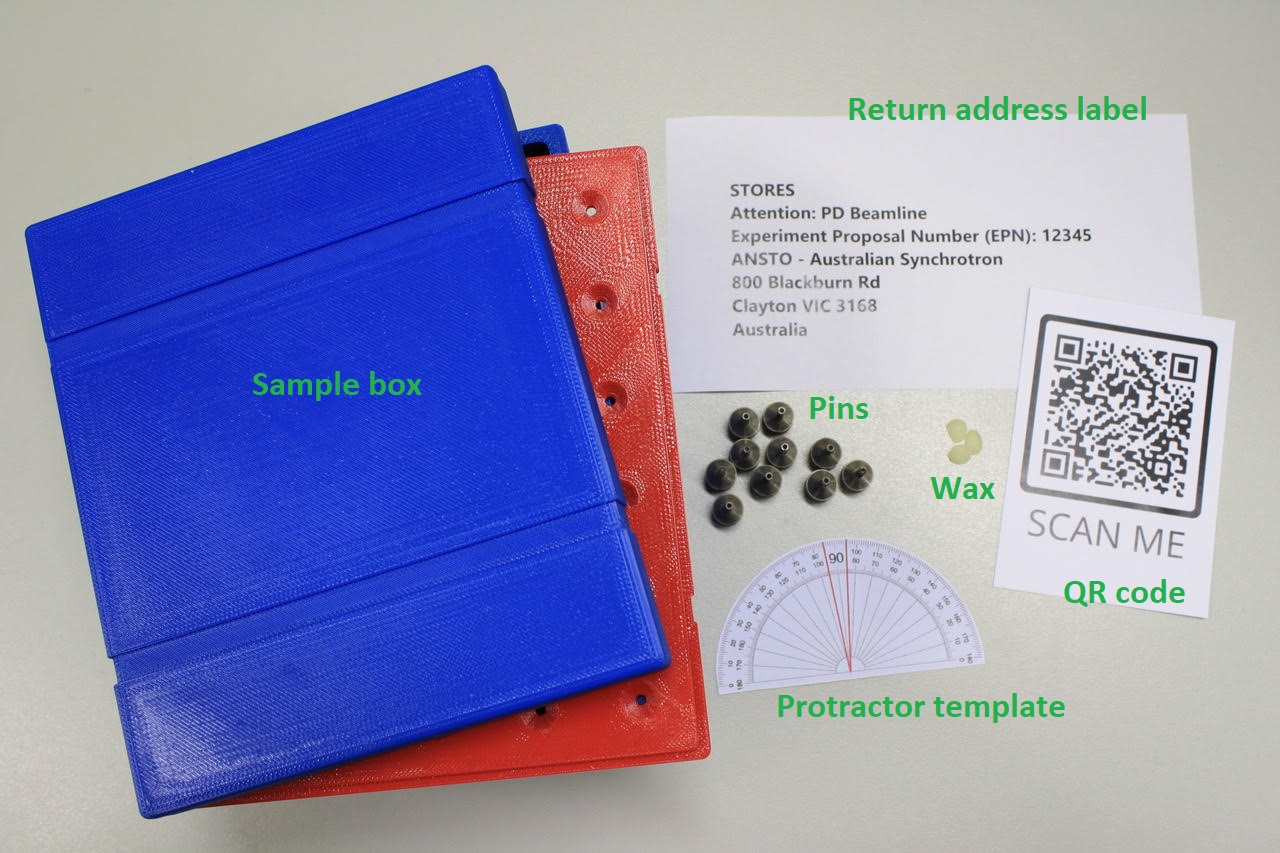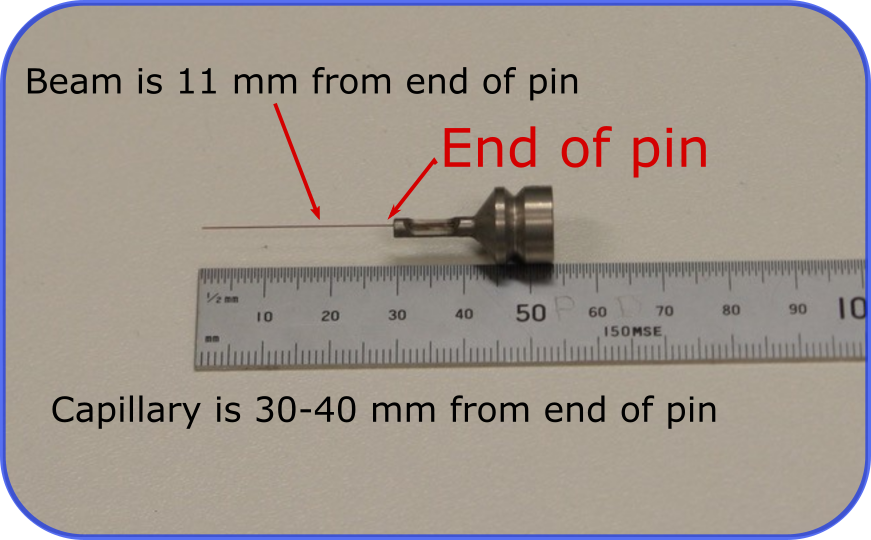The Powder Diffraction beamline offers a rapid access mail-in service for powder samples in capillaries at ambient conditions. This service should not be used as a replacement for merit access that is available 3 times per year.
Commercial users cannot use the mail-in service and need to contact the beamline staff directly at: as-pd@ansto.gov.au
|
|---|
Notes
Groups can only submit 1 proposal per round.
There is a maximum of 20 samples or a 3 hour shift (whichever is smaller), per group per round. Users requiring more samples or beamtime can submit a merit round proposal. The experiment may be cut short if it exceeds the permitted 3 h.
![]() The PD team aim to run samples before the end of the merit round however this cannot be guaranteed as beamtime availability may be affected by unplanned beamline or machine problems.
The PD team aim to run samples before the end of the merit round however this cannot be guaranteed as beamtime availability may be affected by unplanned beamline or machine problems.
Please see our Frequently Asked Questions 🧐
🔍 🌟 Please see the following standard operating procedure (SOP) to assist in accessing the PD rapid access mail-in program.
Standard operating procedure (SOP) |
|---|
Submitting a proposal
Users need to submit a short proposal in the Australian Synchrotron User Portal. Proposals can be submitted in the ~6 rapid access rounds offered per year, and are reviewed by our PAC. This proposal will require:
A title
A brief summary of the research to be undertaken and it's importance, including a description of why this work requires synchrotron radiation
A brief summary of the national benefit & applications of the proposed research,
How many samples will be measured
How much time is required for data collection from each sample
Energy required - The available energies are 21 or 16 keV. Details on how to choose an energy for you samples can be found here in the “Avoiding Fluorescence/ Absorption edges” section.
Address to send sample box kit if proposal is successful
Elemental composition and safety information
Sample & robot spreadsheet
Any lab XRD data you have - Submitting this data with your proposal is highly recommended
![]() The PD team are not responsible for delays in running samples due to the postal address being incorrectly provided by the user.
The PD team are not responsible for delays in running samples due to the postal address being incorrectly provided by the user.
Sample Box Kit
When your proposal is approved we will send you a sample box and pins to mount your samples. The sample box will be sent to the address nominated during proposal submission. Staff will confirm this address before shipping the box and will include a return address label.
Some users with a small number if samples may be asked to send us the samples directly and will not receive a box.
The kit that will be mailed to you will contain:
Sample box
Pins - The number of pins sent will be the number of samples listed on the proposal. All must be returned to the AS when you return the sample box.
Wax
Protractor template
Return mailing address label
QR code with link to this web page (Confluence Cloud) - Here you can find information on how to prepare your samples and send them to the AS.
‼ Users are required to supply their own capillaries as the PD beamline cannot supply them.‼ Please do not submit a proposal unless you have capillaries in time to prepare and send them back to us. |
|---|
Experiment Authorisation
An Experiment Authorisation (EA) will need to be completed and approved before you return your sample box kit. There may be delays in measuring your samples if the box is returned before your EA is approved. The Australian Synchrotron cannot accept samples that are not associated with an approved EA.
A sample robot template needs to completed during proposal and EA submission. This requires the following to be input: sample box position, sample name, sample base/pin ID (printed on the base of the pin, i.e. PD201), number of positions (2), detector position 1 and 2 (difference of 0.5° 2θ), collection time (use the same for each detector position) and data file name. 🌟 The data file name cannot have spaces, or special characters.
Robot Spreadsheet |
|---|
Safety
The PD beamline will only accept low risk materials for mail-in. All hazards of your samples need to be disclosed in the EA form otherwise the experiment will be cancelled. We cannot accept any samples that are:
Radioactive
Explosives or unstable materials
Fatal if swallowed
Fatal in contact with skin
Causes severe skin burns and eye damage
Causes serious eye damage; and
Fatal if inhaled
Sample Preparation & Mounting
Capillaries need to be 0.2-0.7 mm ID, and between 30 - 40 mm in length, as measured from the end of the pin. Larger ID capillaries cannot be sent as they are too fragile. The beam will be centered on the capillary 11 mm from the pin. Capillaries can be purchased from Charles Supper or Hilgenberg.
How to fill and mount a capillary
|
|---|
![]() The PD team can provide information and tips on sample preparation and mounting. We are not responsible for samples that cannot be run due to incorrect mounting, poorly filled capillaries or not enough sample in the capillary.
The PD team can provide information and tips on sample preparation and mounting. We are not responsible for samples that cannot be run due to incorrect mounting, poorly filled capillaries or not enough sample in the capillary.
Sending Samples to the Australian Synchrotron
Please follow the instructions on how to send samples to the Australian Synchrotron. 🌟 All packages need to be addressed to the PD beamline and have the EA number clearly visible as without these there may be a delay in sample receival. There is a return shipping address included in the sample preparation kit. All samples need to be sent according to Australian and international transportation regulations.
‼ Only send samples when your EA has been approved otherwise they may be sent back to you |
|---|
Only send samples when your EA has been approved
All samples must arrive at least 7 days prior to the date of scheduled beamtime otherwise they will be run during the following scheduled beamtime.
PD will check all sample pins have been returned, and all samples are labelled correctly when the sample box is received. 🌟 The samples will not be run unless all pins are returned.
![]() The PD team have to right to delay running samples if all samples pins are not returned to the AS.
The PD team have to right to delay running samples if all samples pins are not returned to the AS.
Address to send samples:
STORES
Attention: PD Beamline
Experiment Proposal Number (EPN): → Don’t forget to fill this in✍
ANSTO - Australian Synchrotron
800 Blackburn Rd
Clayton VIC 3168
Australia
![]() The PD team are not responsible for any capillaries that are received broken or capillaries that break during analysis.
The PD team are not responsible for any capillaries that are received broken or capillaries that break during analysis.
![]() The PD team are not responsible for incorrectly labelled samples, or information incorrectly entered by the user into the robot spreadsheet.
The PD team are not responsible for incorrectly labelled samples, or information incorrectly entered by the user into the robot spreadsheet.
Data Collection
Parameters for data collection need to be specified in the robot spreadsheet at the time the EA is submitted. These parameters cannot be changed once the EA is submitted.
All samples will be run using our robot at the next available beamtime.
After your Experiment
Beamline staff will email you with details on how the data was collected and how to access your data. Please remember to /wiki/spaces/PD/pages/399409224 in all publications!
Sample Disposal
All samples will be disposed of at the Australian Synchrotron.

